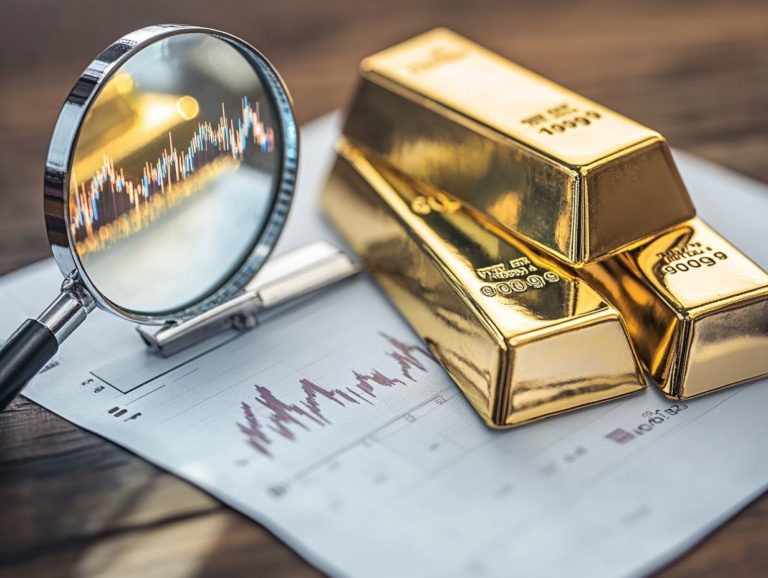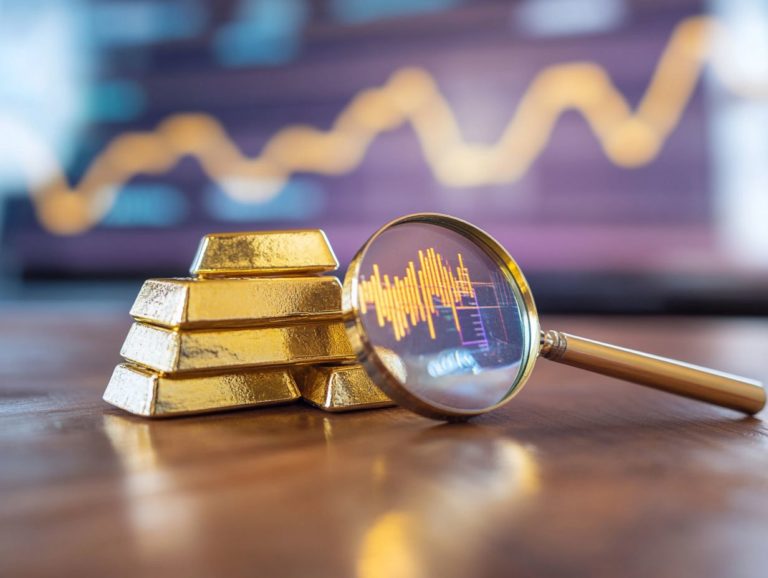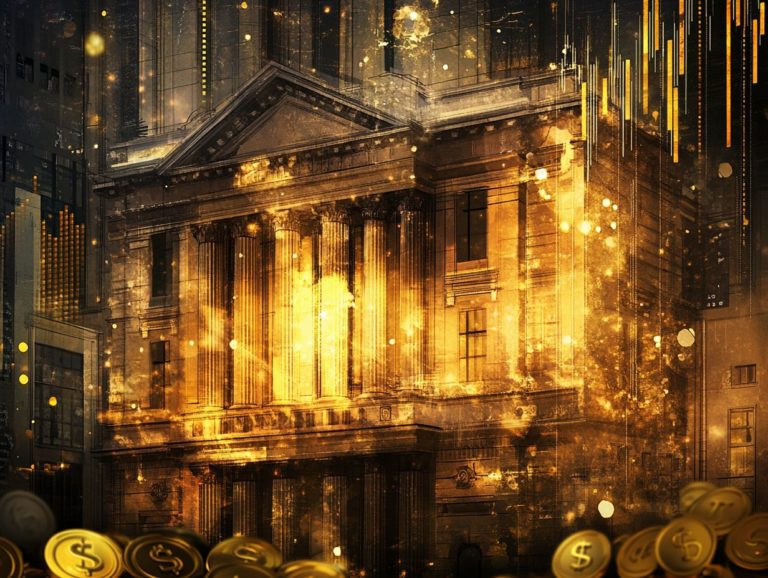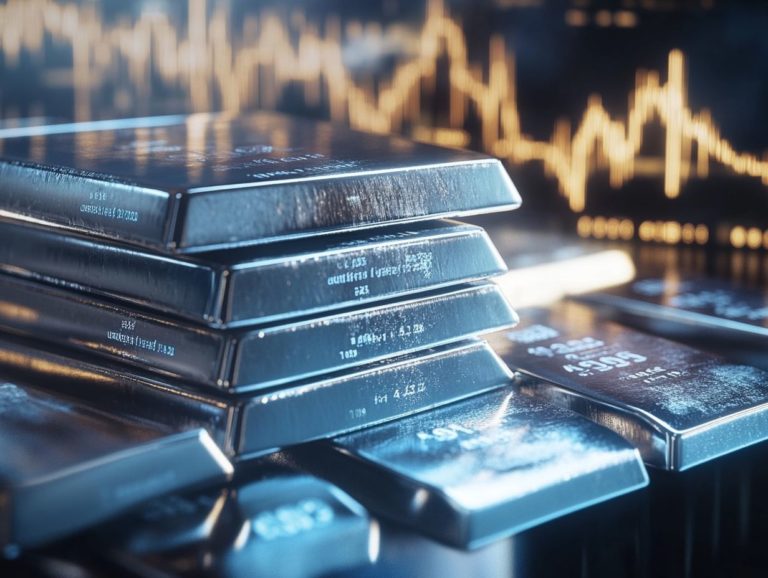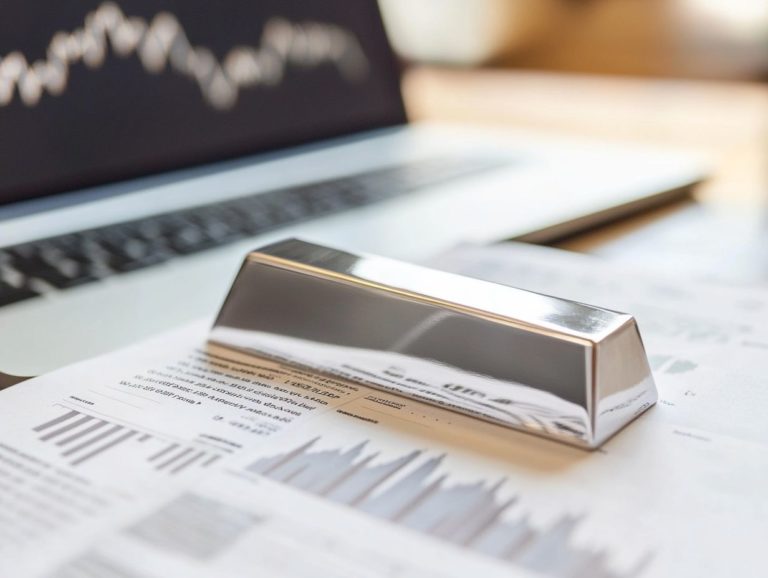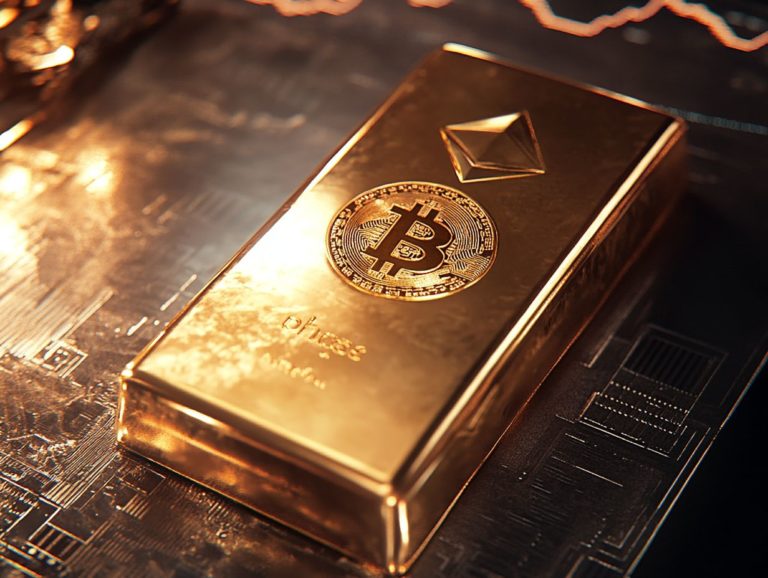Silver Investment: Key Market Indicators
Investing in silver presents a distinctive opportunity for you to diversify your portfolio and engage with a precious metal that boasts both historical significance and contemporary relevance.
This article delves into the details of silver investment, examining the fundamental factors that sway the market such as demand, supply, and economic conditions while highlighting the different types of silver investments available, including both physical and paper options.
You ll uncover the benefits and risks tied to silver along with practical tips tailored for beginners. Essential market indicators will also help you navigate your silver investment journey.
Whether you re a seasoned investor or just starting on this path, you’ll find valuable insights here to support your decision-making.
Contents
- Key Takeaways:
- Factors Affecting the Silver Market
- Types of Silver Investments
- Other Forms of Silver Investments
- Benefits and Risks of Investing in Silver
- How to Get Started with Silver Investment
- Monitoring and Managing Your Silver Investments
- Frequently Asked Questions
- What are the key market indicators for silver investment?
- How does the silver spot price affect silver investment?
- Why is demand from industries important for silver investment?
- How does supply from mining affect silver investment?
- What role do inflation rates play in silver investment?
- How do interest rates impact silver investment?
Key Takeaways:
- Silver investment is a popular choice for investors looking for potential returns and diversification.
- Factors affecting the silver market include demand and supply, industrial shifts, and economic conditions.
- Monitoring key market indicators can help you make informed decisions about your silver investments.
What is Silver Investment?
Silver investment involves purchasing silver to preserve your wealth and potentially reap profits, thanks to its intrinsic value as a precious metal. Unlike traditional stocks or bonds, investing in silver can serve as a hedge against inflation the increase in prices that lowers the purchasing power of money and currency fluctuations, especially during economic instability.
You can choose to acquire physical silver like coins or bars or opt for paper silver through exchange-traded funds (ETFs), which are investment funds that track the market price of silver bullion. The silver market has attracted various investors seeking reliable options amidst rising precious metal prices.
Historically, silver has functioned as both currency and a store of value, tracing back to ancient civilizations, highlighting its enduring significance in the financial landscape.
Currently, market trends suggest a growing interest in silver investment, driven by increasing industrial demand and a rising focus on renewable technologies, where silver is crucial in solar panels and electric vehicles.
As global economic uncertainties loom, savvy investors view silver as a protective asset, especially when currencies lose purchasing power. This view shows why many investors see silver as a smart long-term choice!
This multifaceted approach to silver underscores its value in a well-rounded investment portfolio, reflecting both market dynamics and evolving economic realities.
Factors Affecting the Silver Market
The silver market is shaped by a complex interplay of factors that dictate prices and demand. Therefore, it’s crucial for you to grasp these dynamics to navigate your investment options effectively.
At the heart of this are the principles of supply and demand. An uptick in demand driven by necessities in industry, technology, and emerging markets can trigger noteworthy price surges. Broader economic conditions also influence market stability and liquidity, resulting in a volatile environment for silver as a commodity.
Demand and Supply
The dynamics of demand and supply are pivotal in determining silver prices within the commodity market, reflecting broader trends in the global economy. Industries like photovoltaics and jewelry manufacturing underscore silver’s essential role, and you’ll notice that demand fluctuates based on technological advancements and consumer preferences.
On the supply side, factors such as mining production levels and geopolitical influences from key silver-producing countries like Mexico, China, and Peru can greatly affect market availability and, consequently, price movements.
Take Mexico, for example. It accounts for a substantial portion of global silver output, and fluctuations in mining regulations and environmental policies there can either boost or restrict production capabilities.
Consider the rising interest in electric vehicles, which rely heavily on silver for various components. This increasing industrial demand often competes with consumer markets, where shifts in fashion trends and investment behaviors can further skew the balance.
The interplay of these elements not only illustrates the volatility of silver prices but also emphasizes the importance of staying attuned to both macroeconomic developments and localized mining dynamics that shape the industry s landscape.
Industrial and Economic Factors
Industrial and economic factors significantly shape the silver market. They influence demand across various applications and the price movements observed over time.
With the rise of technology and an increasing appetite for renewable energy solutions, silver’s role in photovoltaics has exploded. This situation puts extra strain on supply chains and impacts prices.
When economic trends shift think inflation rates or global financial climates investors often turn to silver as a safe haven. This inevitably sways market sentiment and shapes the behavior of the investment community.
As industries ramp up their use of silver for its exceptional electrical conductivity and antimicrobial properties, the market landscape becomes increasingly intricate. Advancements in electronics and medical technology continue to broaden silver’s applications, increasing the need for this precious metal.
Economic factors like fluctuating interest rates and geopolitical tensions spark speculative trading in silver, adding further complexity to market dynamics. Analysts frequently assess how government policies aimed at economic recovery might influence silver investments. This highlights the ongoing interplay between industrial demand and macroeconomic factors that chart the market’s course.
Types of Silver Investments
Exciting opportunities await you as an investor in silver! You have a range of enticing options at your disposal, each with distinct characteristics and benefits.
Physical silver, such as bullion coins and bars, offers you a tangible asset to hold. This instills a sense of security amidst volatile financial climates.
On the other hand, paper silver traded through financial instruments like exchange-traded funds (ETFs) (which are investment funds traded on stock exchanges) or futures contracts (agreements to buy or sell at a future date) provides a pathway for investment without the need for physical storage. This appeals to those who prioritize liquidity and seamless trading.
Understanding these distinctions is essential for you to make informed investment choices that align with your financial goals.
Physical Silver vs. Paper Silver
The debate between physical silver and paper silver often centers on the inherent value, ownership, and convenience associated with each investment type. When you opt for physical silver, such as bullion bars and coins from the US Mint, you secure a direct claim on the metal. This provides a robust hedge against inflation and economic turmoil.
On the flip side, paper silver represented through contracts or ETFs allows you to engage in the silver market without the complexities of storage and security. This is ideal for those who prioritize liquidity over tangible assets.
Choosing between these investment paths requires careful consideration of several factors. For instance, physical silver necessitates safe storage, which can come with costs and logistical challenges. There are also risks of theft or damage.
In contrast, paper silver offers easier market access and is generally more convenient for trading. However, it lacks the sense of security that comes from holding the actual metal.
Market dynamics and economic trends play significant roles in shaping your decisions. Rising inflation may heighten your desire for physical silver as a safe haven, while market volatility could lead you to lean toward paper silver for quicker transactions. Exploring 5 silver investment strategies for beginners can help you navigate these choices effectively.
Other Forms of Silver Investments
Beyond the traditional avenues of silver investment, you can find many opportunities that will enhance your portfolio and deepen your exposure to the silver market. Consider diving into silver-focused ETFs (Exchange-Traded Funds) that carefully follow the metal’s price movements. Also, explore investments in mining stocks from companies nestled in major silver-producing regions.
With the rising interest in cryptocurrency, it’s fascinating how some investors are drawing parallels between digital assets and precious metals like silver. They are crafting innovative strategies that seamlessly integrate both asset classes.
For instance, silver ETFs like the iShares Silver Trust (SLV) offer you a straightforward route to gain exposure without the hassle of purchasing physical metal. Companies like Pan American Silver and Coeur Mining present enticing opportunities to invest in the success of silver mining operations potentially delivering higher returns during exhilarating price surges.
The intersection of silver and cryptocurrency is particularly captivating. Some investors are exploring digital tokens backed by silver reserves, effectively merging the stability of precious metals with the nimbleness of blockchain technology a secure system for recording transactions. This crossover broadens your investment horizons and caters to your desire to diversify your holdings in an ever-evolving financial landscape.
Benefits and Risks of Investing in Silver
Investing in silver presents a unique blend of benefits and risks that you should weigh thoughtfully against your financial goals and the current market landscape.
On one hand, silver acts as a reliable hedge against inflation and currency fluctuations, frequently appreciating in value during economic downturns. You should be aware that the silver market can be quite volatile, with price movements swayed by various influences, including demand from manufacturers, global economic trends, and speculative trading practices. Additionally, understanding the 5 signs of a good gold investment opportunity can also enhance your investment strategy.
By grasping these dynamics, you can make more informed and strategic investment decisions.
Potential Returns and Risks
The potential returns and risks associated with silver investments are largely shaped by market trends and the overall financial climate, making it essential for you to stay well-informed. Historically, silver has seen significant price surges, especially during economic uncertainty, presenting lucrative investment opportunities.
However, the market is also marked by volatility, with prices vulnerable to declines due to fluctuations in demand, production levels, and speculative actions by traders. As economic indicators fluctuate like inflation rates and currency strength, understanding the 5 key indicators for silver investment success becomes crucial for anyone considering silver as part of their portfolio.
Market dynamics, particularly industrial demand from the technology and automotive sectors, can dramatically sway silver prices. Equally important is your awareness of geopolitical events and mining output disruptions, as these factors can create sudden market shifts.
By analyzing historical data and monitoring emerging trends, you can navigate the potential rewards and inherent risks tied to silver investments with greater confidence.
How to Get Started with Silver Investment
Embarking on a silver investment journey requires a solid grasp of market dynamics and a well-defined strategy that aligns seamlessly with your financial objectives.
Begin by educating yourself about the diverse avenues of silver investment, such as physical silver, ETFs, and mining stocks. Establish clear goals concerning your investment timelines and understand your own risk tolerance.
These foundational steps will empower you to navigate the silver market confidently and maximize your potential returns.
Tips for Beginners
If you’re new to silver investment, a few strategic tips can boost your chances of success in this dynamic market. Stay informed about the latest trends and price movements. Use resources like the Silver Institute and reliable financial news outlets to enhance your understanding.
Spread out your investment portfolio by including different forms of silver investments like bullion and ETFs (Exchange-Traded Funds). This can help reduce risks while maximizing potential returns.
As a novice investor, it’s wise to set clear financial goals and define your risk tolerance before diving in. Starting with smaller investments allows you to gain valuable experience while adjusting to market fluctuations.
Consider attending workshops or webinars led by industry experts. These can provide valuable insights and practical tips. Joining online forums or communities focused on silver investment enables you to share experiences and gather advice from seasoned investors.
Keep an eye on economic indicators that influence silver prices, such as inflation rates and currency strength. This context is crucial for making informed decisions in the ever-evolving silver market.
Monitoring and Managing Your Silver Investments
Keep a close watch on your silver investments. This habit can maximize your returns and minimize risks in a constantly shifting market. Regularly track key market indicators, including price movements, supply and demand trends, and global economic conditions to make informed choices.
Engaging with the investment community through online forums can offer valuable insights and strategies for managing your silver holdings and adapting to market changes.
Key Market Indicators to Watch
Key market indicators shape the direction of silver prices and the overall investment landscape. Pay attention to inflation rates, interest rates, and supply chain trends, as these factors can significantly sway market trends and price volatility.
By monitoring the performance of related assets, like gold and even cryptocurrencies, you can gain insights into silver’s position within the broader commodity markets.
Geopolitical events and global economic policies can cause sudden shifts in market sentiment. For instance, a sudden conflict or changes in trade agreements could increase demand for silver as a safe-haven asset.
Changes in mining regulations and technological advancements can also influence the supply side, impacting prices.
By watching these indicators, you can navigate the complex silver market more effectively and make informed decisions that align with your investment objectives.
Frequently Asked Questions
What are the key market indicators for silver investment?
The key market indicators for silver investment include the silver spot price, demand from industries, supply from mining, inflation rates, interest rates, and global economic conditions.
How does the silver spot price affect silver investment?
The silver spot price, which is the current market price for one troy ounce of silver, is a vital indicator for silver investment. Its fluctuations impact the value of silver investments and the returns investors can expect.
Why is demand from industries important for silver investment?
Silver is used in various industries, such as electronics, solar panels, and jewelry. Therefore, demand from these sectors can significantly impact silver prices and the profitability of investments.
How does supply from mining affect silver investment?
The supply of silver is also an important market indicator. A decrease in supply due to factors like mining disruptions or reduced production can drive up silver prices and potentially enhance the value of investments.
What role do inflation rates play in silver investment?
Inflation rates measure the increase in the prices of goods and services, which can affect the value of silver investments. As inflation rises, currency values may decline, making silver a more attractive investment as it often maintains its value.
Don t miss out on these strategies! They could be your ticket to success in the silver market.
How do interest rates impact silver investment?
Interest rates significantly influence silver investments. When rates are low, investors tend to turn to silver for potentially higher returns.
High interest rates can make other investments more appealing, leading to a drop in silver’s demand. Stay informed about these trends to make smarter investment choices!










